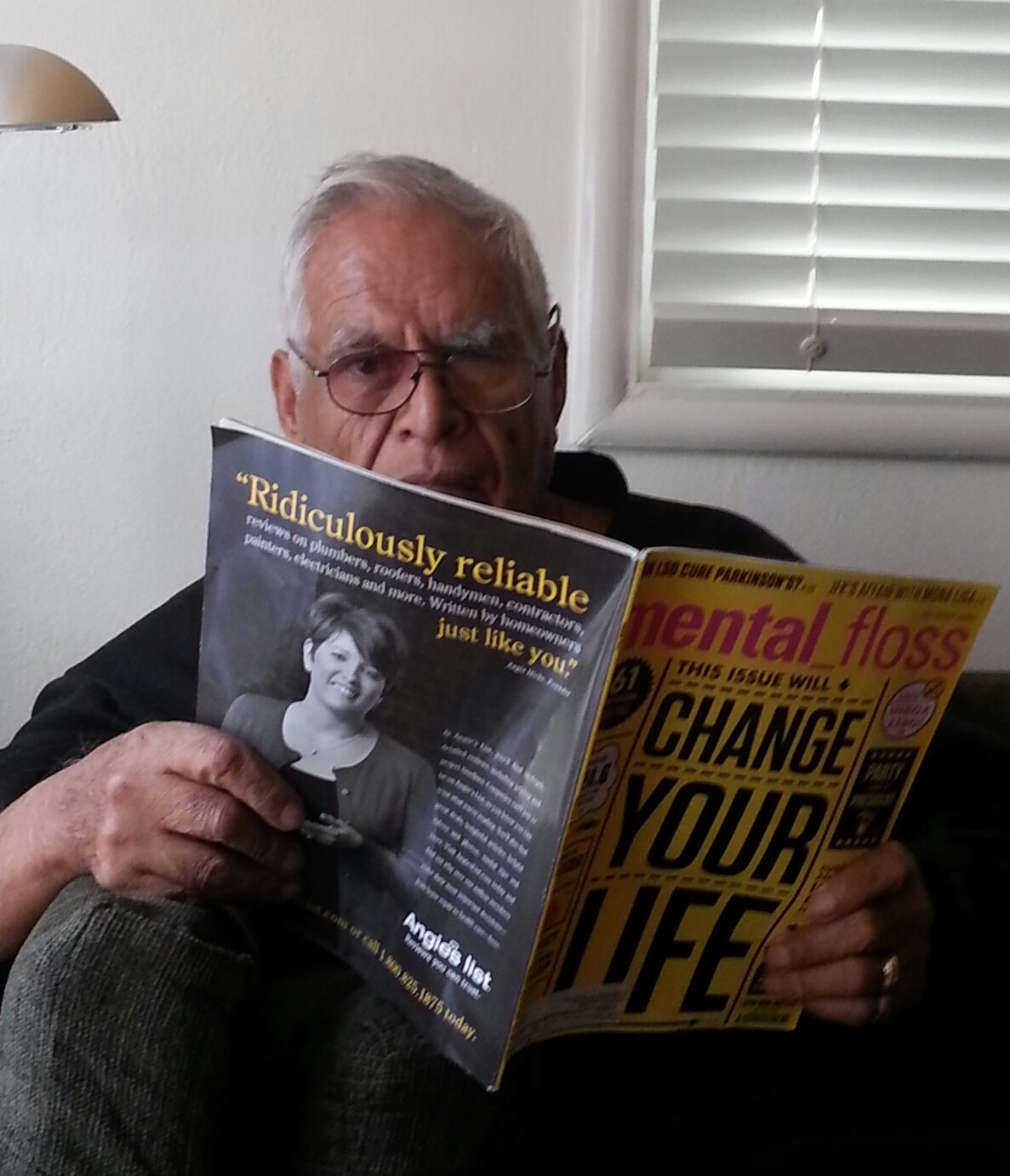Starting a Personal Practice (a personal story)
Practice can change your life
This is a photo of my Dad reading Mental Floss magazine taken a few years before he passed away (I love you, Dad!). I like that the cover in the photo reads, “Change your Life,” because that is what happens when you practice anything in your life regularly.
Practice is the chipping away of a sense of limitation. It is good to chip away at your sense of limitation as often as possible until the sense of limitation diminishes or even goes away completely. That is when mastery becomes possible, and you can say you become “good at it”—whatever it is you have been practicing. More importantly, practicing something and reducing a sense of limitation also leads to a sense of freedom inside. Ah! That’s when life has room to breathe and grow. This freedom then leads to a sense of possibility to move and engage in life in new ways.
A little story about getting to practice
My big secret as a teacher of movement arts is that I learn slowly. Fortunately, I have had great teachers who were very patient with me. For the longest time, I could not remember movements, how to do movements, and never mind trying to remember sequences of movements. It just did not happen. My mind was like a sieve. That said, my goodness, I remember truly enjoying yoga and meditation classes at the time. I took yoga classes and even subscribed to Yoga Journal, which in just about every issue always features entire articles describing a breakdown and analysis of yoga poses and movement that were almost always lost on me. A friend of mine from yoga class at the time said to me, “I’m just here, because I like wearing yoga clothes.” I practiced yoga in sweats and a t-shirt, so for me it was not the clothes. I did yoga, because I was stressed out of my mind in the deadline-driven Silicon Valley job I had as a technical writer and manager. That was me 30+ years ago: two left feet and ready to take my place in the back row of the class where I felt safe. I realize now I was basically hiding back there. That was just fine with me.
But then something changed
Lots of things changed, actually; and I am going to share the three things that pushed me into actively pursuing personal practice of mindbody arts, which then led to remembering movements and movement sequences, and then to leading classes and finally changing careers. It turns out, there are “gateway” practices that seem to open doors for you and lead to bigger things.
Thing One: Breath Practice
There was one breath practice that changed everything and is probably the reason I became a teacher of mindbody arts. The practice is Alternate Nostril Breathing. Wow. That was it. I had been going to yoga class for maybe a year or so when I got to experience it, practice it.
That one little breath practice made me feel embodied and truly present. Ah. Doing a few rounds of alternate nostril breathing produced a buzzy feeling inside the chamber of my nose and up into my sinuses, which was sort of pleasant but also new and weird. It got my attention. The eyes and body were soft from practicing yoga poses and rhythmic breathing. The room was softly lit, and there was a feeling of physical space and wellbeing. It was an evening yoga class I did after work. I remember it was nighttime, and the short drive home felt easy to navigate and almost smooth. I was not a good driver at the time, so having a pleasant driving experience after class was something new. Years later, I realized that my yoga teacher, Mary Miller, at the time had been using Qigong movements to get the group in sync at the start of yoga class. Ah! No wonder I loved her classes.
So, I found out something important. What you need to be able to remember things, especially movement and movement sequences, is presence. You need to be very present and in-the-moment. It turns out being present has a feeling. I remember the feeling in my head felt clear, and my eyes felt like they had settled back into their sockets. Soft eyes, you call it. My body was relaxed, and there was this buzzing feeling of light vibration in my face mostly, and also a feeling of soft shoulders and body weight dropping down to the earth. Not until that night, doing breath practices after yoga class, had I ever felt comfortable in a cross-legged position before. That evening, I felt like I could sit cross-legged forever. The beauty of breath practice is that a little goes a long way, and for me a little intentful and conscious breath practice to this day continues to be a simple yet profound practice. Truly.
After that, I became very curious about what exactly happened during that breath practice, and what became available to me in that moment of breath control. This curiosity about breath practice made me want to practice more. So I did.
Thing Two: Making Friends through Meditation and Bodywork
I started taking meditation classes after that, and I got bodywork on a regular schedule. Unfortunately, I was zealous and ambitious, trying to wake up at 4:00am to meditate every morning for weeks at a time. It almost ruined relationships, and this monkish schedule was impossible to sustain. I was a wreck at a desk job for a while while I wrapped my head and life around practice. Hence, the need for bodywork: I got massage to ease the tense muscles, and I had sessions in a mindbody energy work called the Rubenfeld Synergy Method that was like a combination of Reiki and shamanism. After some regular sessions, I came to think of getting massage and getting the mindbody work sessions as a kind of assisted meditation. The practitioners were good awareness coaches for me. These things also led me to study more and to obtain bodywork certifications. It was great to pursue these paths and to make friends along the way. Friends are a big part of creating and having a personal mindbody practice.
It is helpful to talk about your mindbody experiences with others who are sympathetic. Some people call friends like these dharma friends, where dharma means the teachings on the “nature of reality,” and dharma teachers are often committed to growth, love, compassion, and wisdom. My favorite phrase to describe this way of thinking and being is that you cultivate the nature of nature. This was spoken by a true dharma friend. Dharma friends are very special friends, people who prioritize growth and practices like honest communication. It is great fortune to be around such people. It is an honor to call them friends. Like all people, dharma friends are not perfect people, but you always learn something about yourself or about life around them.
At the time, I also started doing Tai Chi, and my first Tai Chi teacher, Tony Knickerbocker, was a dharma friend. I have since studied with several Tai Chi masters.
Thing Three: One day the teacher was very late
There was also something very ordinary that spurred me to practice Tai Chi on my own for the first time, in public with everyone watching. It was during the first few years of doing Tai Chi. I always practiced only with the teacher present, and I waited along with the other students for the teacher if he was late for class. But one day, the teacher was very late. This happens. I remember the students were sitting around or standing around talking, waiting for the teacher and not doing Tai Chi. I remember it was a moment of confidence or freedom, or something like that, moving in me when I decided to just do the Tai Chi forms I knew and to heck with it if I mess up. “Just do what you remember. No one really cares,” I remember thinking. And so I did what I remembered of the Tai Chi Chen Style Lao Jia first form. I think I got through six or maybe eight movements. It is a long form of of 85+ movements. But those few movements I did went okay. Tony Wong, my Chen Tai Chi Teacher, actually saw some of my “performance.” “Don’t stop,” he said. But I did not know anymore moves. After that, Tony asked me to lead the group every now and then, and then I joined the “official” group of class leaders. Later some of us in that group got certified to teach. So, the lesson is this. Imperfection is a form of freedom. Just go ahead and move and see what happens. True practice can happen when you can relax into the moment, whatever it is, and just do it however you know. The polishing and refining happens later and over time.
The Freedom Inside
The meditative arts are not to be hurried or imposed on anyone. Timing is precious! The search for appropriate levels of effort is a significant part of the journey, and these must come from within. Zeal is great, but finding something sustainable is better. That means understanding your motivations, talking to friends, and seeking assistance sometimes. I find the meditative arts, including the martial arts, are a constant reminder to truly observe the cycles of growth and honor each point of the process as valid and whole. As you do so, you hone your ability to trust the underlying wholeness of the growth process and train yourself to release your sense of limitation—to the best of your ability in the moment. This takes patience and commitment, especially in a culture where making comparisons, casting judgments, and doing evaluations are the norm.
Gratitude can replace condemnation, and you can then be free to just be yourself.
Author W. Timothy Gallwey captures the essence of this teaching in his observations about how to regard the growth phases of an ordinary rose:
“When we plant a rose seed in the earth, we notice that it is small, but we do not criticize it as ‘rootless and stemless.’ We treat it as a seed, giving it the water and nourishment required of a seed. When it first shoots up out of the earth, we don't condem it as immature and underdeveloped; nor do we criticize the buds for not being open when they appear. We stand in wonder at the process taking place and give the plant the care it needs at each stage of its development. The rose is a rose from the time it is a seed to the time it dies. Within it, at all times, it contains its whole potential. It seems to be constantly in the process of change; yet at each state, at each moment, it is perfectly all right as it is.” ― W. Timothy Gallwey, The Inner Game of Tennis: The Classic Guide to the Mental Side of Peak Performance


